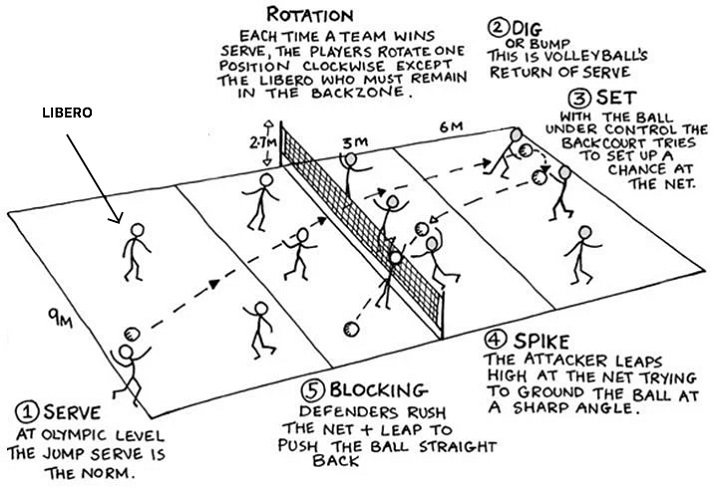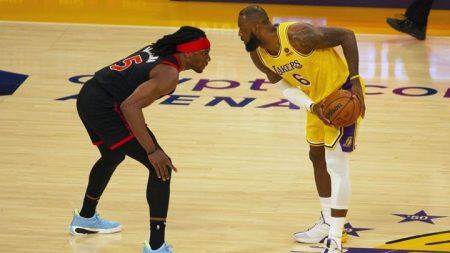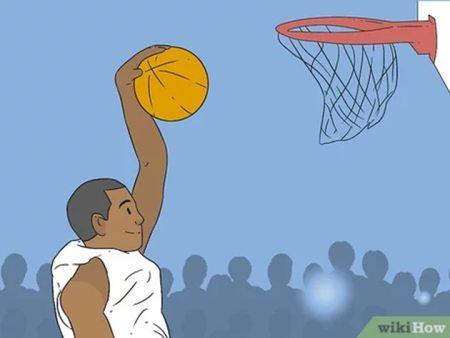The Basics of Volleyball Court Layout
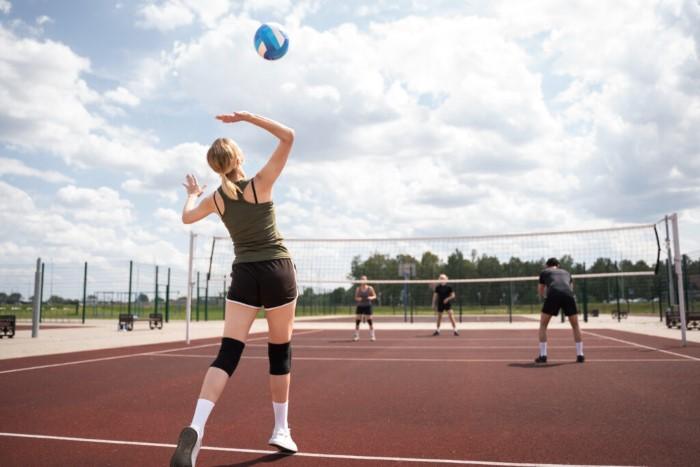
Before diving into specific positions, it’s essential to understand the layout of a volleyball court. A standard indoor volleyball court measures 18 meters long and 9 meters wide, divided into two equal halves by a net. The court is marked with various lines, including:
- Attack Line: This line is located 3 meters from the net and separates the front row from the back row. Players in the front row can attack the ball from anywhere in their half, while back-row players must remain behind this line when attacking.
- Service Line: This line marks where players must serve the ball from.
- End Lines: These are the lines at the back of the court, marking the boundaries of play.
Understanding these lines is critical as they dictate the movements and strategies players employ during the game.
The Six Positions in Volleyball
Outside Hitter (Left Side Hitter)
The outside hitter, also known as the left-side hitter, is one of the most crucial positions on the volleyball court. This player is typically responsible for attacking the ball from the front left side of the court and plays a significant role in both offensive and defensive plays.
Responsibilities:
- Attacking: The outside hitter is primarily responsible for attacking the ball, aiming for a successful spike over the net. They must be skilled in reading the block and finding open spots on the court.
- Passing: This player often receives serves and plays a key role in the team’s serve-receive formation.
- Defense: Outside hitters are expected to play defense, making them responsible for digging (defending against) attacks from the opposing team.
Skills Required:
- Strong hitting and spiking abilities.
- Excellent passing and ball control skills.
- Good defensive skills, including digging and blocking.
Middle Blocker
The middle blocker, or middle hitter, plays a pivotal role in defense and offense at the net. Positioned centrally, this player is often the first line of defense against opposing attacks.
Responsibilities:
- Blocking: The middle blocker must effectively read the opposing team’s offense and position themselves to block attacks, minimizing points scored against their team.
- Attacking: They are also involved in offensive plays, executing quick attacks in conjunction with the setter.
- Covering: After an attack, middle blockers must quickly transition to defensive positioning.
Skills Required:
- Excellent jumping ability and timing for blocking.
- Quick footwork to move across the net.
- Strong communication skills to coordinate plays with teammates.
Setter
The setter is often regarded as the playmaker of the team. Positioned in the front row, the setter’s primary responsibility is to deliver accurate sets to the attackers.
Responsibilities:
- Setting the Ball: The setter determines which hitter will receive the ball, delivering accurate sets to allow for effective attacks.
- Defense: They also play a role in defense and are often involved in digging and covering tips or off-speed shots.
- Decision Making: The setter must make quick decisions during play, considering the opposing team’s defense and the strengths of their attackers.
Skills Required:
- Exceptional hand-eye coordination for precise sets.
- Strong strategic understanding of the game.
- Excellent communication skills to coordinate plays with hitters.
Opposite Hitter (Right Side Hitter)
The opposite hitter, or right-side hitter, is positioned opposite the setter and plays a critical role in both offense and defense.
Responsibilities:
- Attacking: This player is responsible for attacking from the right side of the court, often facing the opposing team’s strongest blockers.
- Blocking: They also assist in blocking against opposing outside hitters, providing additional support at the net.
- Defense: The opposite hitter must be prepared to play defense and transition quickly between offensive and defensive roles.
Skills Required:
- Strong attacking skills, particularly from the right side.
- Good defensive skills to contribute to blocking and digging.
- Versatility to switch between offensive and defensive strategies.
Libero
The libero is a specialized defensive player, often wearing a different color jersey. This position is crucial for improving the team’s overall defense.
Responsibilities:
- Receiving Serves: The libero primarily focuses on receiving serves and playing defense against attacks.
- Digging: They are skilled at digging and preventing the ball from hitting the court, providing stability to the team’s defense.
- Ball Control: The libero must have excellent ball control, ensuring accurate passes to the setter.
Skills Required:
- Exceptional passing and defensive skills.
- Quick reflexes and anticipation to react to attacks.
- Strong communication skills to organize the defense.
Defensive Specialist
The defensive specialist (DS) is similar to the libero but does not have the same restrictions. This player is also focused on defense, coming in for front-row players to strengthen the team’s backcourt.
Responsibilities:
- Substituting: The defensive specialist substitutes for front-row players when the team is in the back row, enhancing defensive capabilities.
- Receiving: They are often responsible for receiving serves and playing defense against attacks.
- Setting Up Defense: The defensive specialist helps set up the team’s defensive formations and strategies.
Skills Required:
- Strong defensive and passing skills.
- Good understanding of positioning and court awareness.
- Ability to read the opposing team’s offensive strategies.
Positioning on the Court
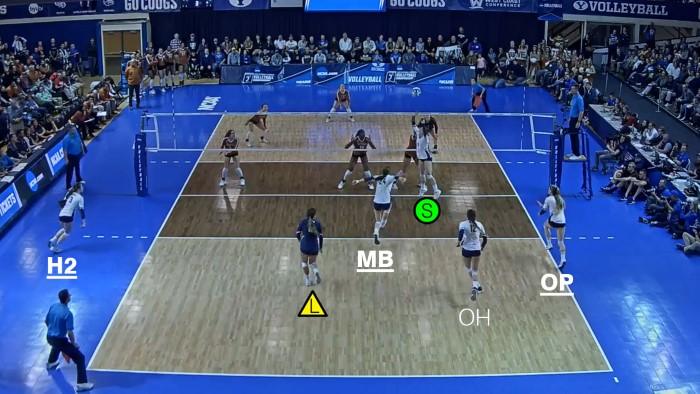
Rotations and Positions
In volleyball, teams rotate positions every time they win the serve from the opponent. This rotation ensures that all players take turns in various roles on the court, including serving, attacking, and playing defense.
The Rotation System
- Rotation Order: Teams must follow a specific rotation order, moving clockwise around the court. This ensures that each player has the opportunity to play in different positions throughout the match.
- Front Row and Back Row: During each rotation, three players will be in the front row (the attackers and blockers) and three in the back row (the defenders and serve receivers).
Position Adjustments During Play
- Transitioning: Players often need to transition quickly between offensive and defensive roles, adapting their positioning based on the flow of the game.
- Communication: Effective communication is vital, especially during transitions, to ensure that all players are aware of their roles and responsibilities.
Strategies for Each Position
Outside Hitter Strategy
- Reading the Block: Outside hitters must learn to read the opponent’s blockers and find gaps in the defense.
- Variety in Attacks: They should develop a variety of attacking techniques, including spikes, tips, and roll shots, to keep the defense guessing.
Middle Blocker Strategy
- Timing and Anticipation: Middle blockers must focus on timing their jumps to maximize their chances of successfully blocking attacks.
- Quick Offense: They should work closely with the setter to execute quick attacks, catching the opposing team off guard.
Setter Strategy
- Effective Communication: The setter should maintain constant communication with attackers to understand their preferences and adjust sets accordingly.
- Variety in Sets: Using different types of sets, such as high sets or quick sets, can create opportunities for successful attacks.
Opposite Hitter Strategy
- Effective Blocking: Opposite hitters should focus on effective blocking techniques to support their teammates and disrupt the opponent’s attacks.
- Versatile Attacks: Developing a diverse attacking repertoire will allow them to be effective against various types of defenses.
Libero Strategy
- Positioning and Movement: Liberos must position themselves strategically to maximize their ability to dig and receive serves.
- Reading the Game: Anticipating plays and reading the opponent’s strategies is crucial for effective defense.
Defensive Specialist Strategy
- Adaptability: Defensive specialists should be adaptable, capable of adjusting to different players and play styles.
- Focus on Fundamentals: Mastering the fundamentals of passing and digging will enhance their effectiveness on the court.
Understanding volleyball positions on the court is essential for any player or fan of the game. Each position contributes uniquely to the team’s performance, requiring specific skills, responsibilities, and strategies.
Whether you are an aspiring player or simply a fan enjoying the sport, recognizing the roles of the outside hitter, middle blocker, setter, opposite hitter, libero, and defensive specialist can enhance your appreciation of volleyball. As players work together, utilizing their strengths and communicating effectively, they create a cohesive unit capable of executing complex plays and strategies. This teamwork, combined with individual skill, is what makes volleyball such an exciting and dynamic sport.
Mastering these positions not only elevates individual performance but also enhances the team’s overall success on the court. Embrace the sport, understand your role, and enjoy the thrill of volleyball!

